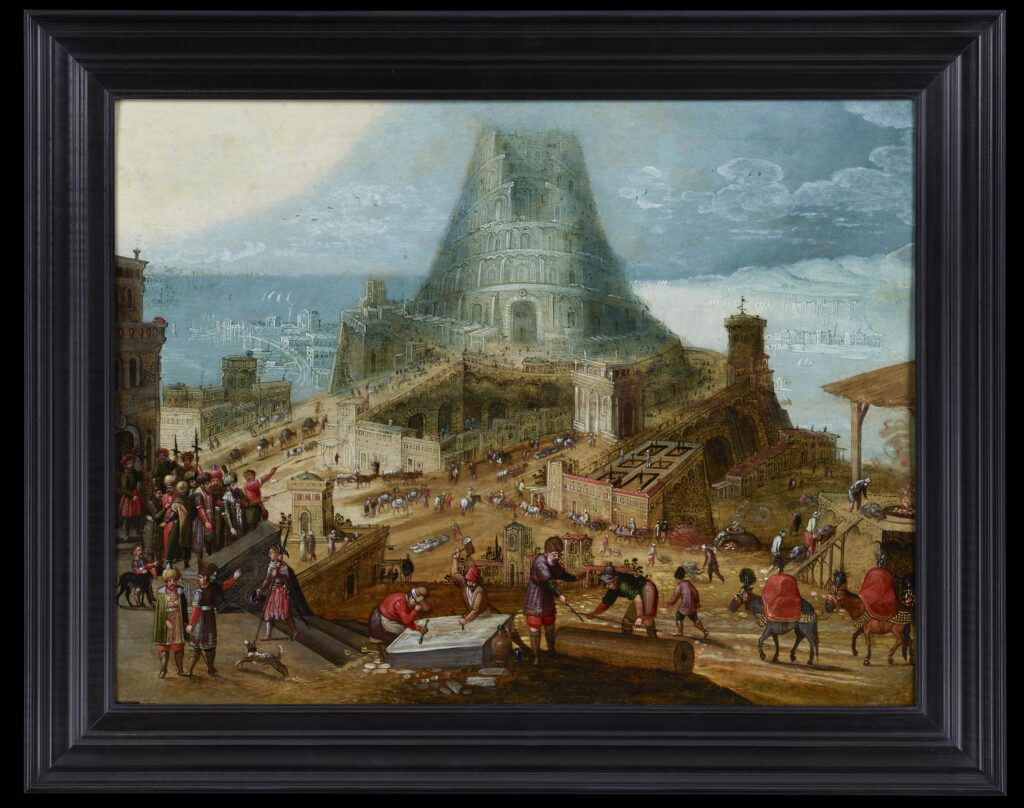Hendrick van Cleve III
circa 1525 - between 1590-95
The Building of the Tower of Babel

Essay:
Hendrick van Cleve III was a Flemish painter and draughtsman known for his landscapes in the tradition of the World Landscape of Joachim Patinir. In particular he and his workshop are known for producing many Mannerist style views of the construction of the Tower of Babel. Aside from his father van Cleve's first master was Frans Floris and he was elected to the Antwerp Guild in 1551.
As a young man van Cleve travelled to Italy (the exact years are unclear) and made many drawings of the architecture, many of which survive today. They appear to have given him a large amount of material to use in his imaginary landscapes where he often grouped classical and more modern grand architectural styles together. For instance, Mannerist architecture can be seen next door to classical arches and aqueducts in some of his landscapes. Often van Cleve fabricated the buildings and sculptures entirely and so a great degree of variety and inventiveness is evident in his works.
-
The Tower of Babel was a common subject in the Southern Netherlands (particularly in Antwerp) in the second half of the 16th century. While Pieter Breughel the Elder was not the first artist to paint the subject, he did much to popularise it. Subsequent depictions, including those by van Cleve, tend to derive from the iconography in Breughel's two main prototypes (today housed in the Kunsthistorisches Museum, Vienna; and Museum Boijmans Van Beuningen, Rotterdam). Thus, the Tower is often represented as under construction, while earlier depictions focused on the fiery destruction. A cone or spiral architectural design is common (perhaps inspired by the Roman Colosseum), as are figures standing on the terrace observing the view and acting as a repoussoir.
The Old Testament story comes from the Book of Genesis 11: 1-9. The underlying moral is to chastise the descendants of Noah for their prideful attempt to build the Tower to reach all the way up to heaven. Seeing this as a challenge to his authority God destroyed the Tower and the surrounding city. For good measure He also scattered the builders and confused their language. The builders could no longer understand one another and so collaboration (and hubris) on this scale would not be possible again.
The fractious political and religious milieu of the Protestant Reformation contributed greatly to the popularity of the Tower in art and references in sermons and pamphlets. The Dutch and Flemish framed the story to criticise the Catholic Church for their pride, ostentatious building projects, and their insistence on using one language: Latin.
In the present picture, as in many other versions, a kingly figure with his attendants appears in the foreground. This is presumably Nimrod who ordered the Tower's erection. He stands on the terrace of a palace and his attendant gestures to the Tower with its mighty city, the harbour, and busy workmen. From multiple angles the composition draws the eye to the central Tower. The surrounding buildings are a medley of architectural styles from different areas and periods including a triumphal arch, baroque gardens, towers and Renaissance palazzos and chapels.
The attribution to Follower of Hendrick van Cleve has been suggested by Suzanne Loemers of the RKD in the Netherlands.
Provenance:
Anon. sale; Christie's, London, 29 Sept. 1950, lot 158, (as 'Valckenburg'), (sold for 23 guineas 2 shillings).
Private Collection, Spain.